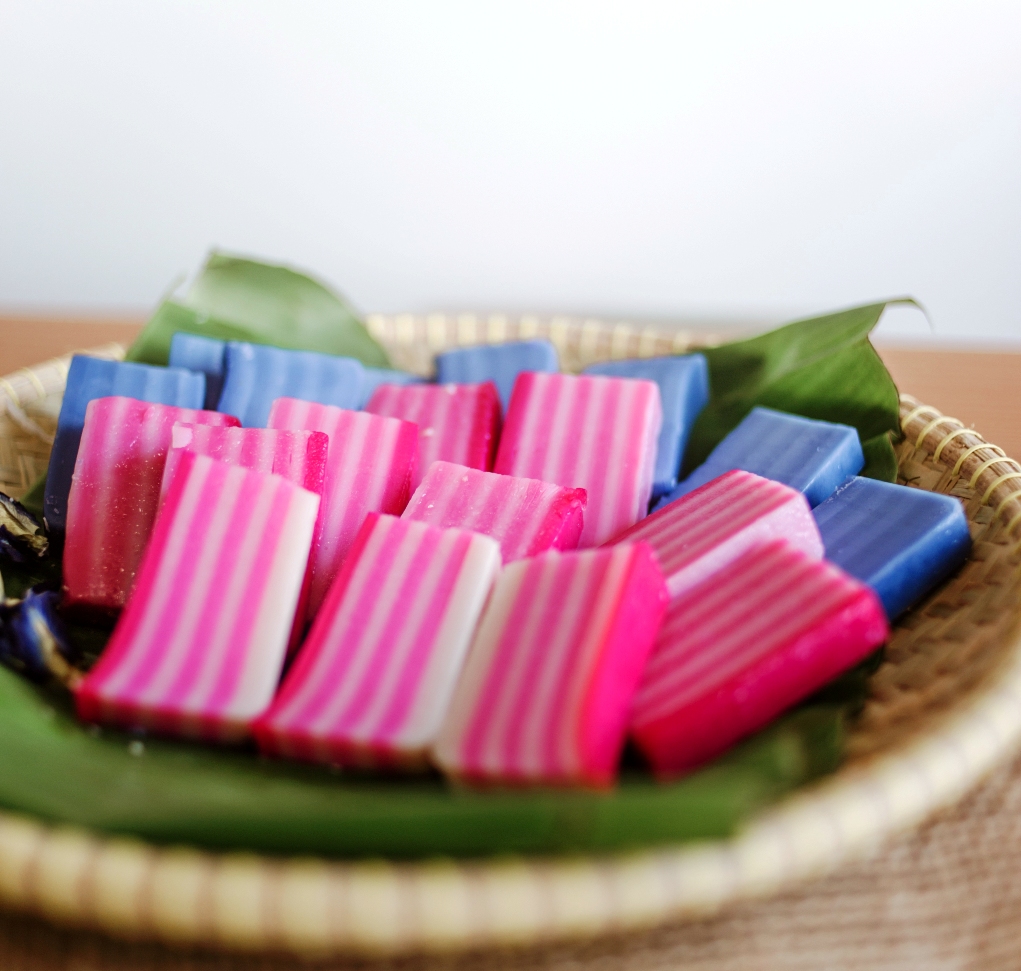
When I was a young ‘ciku’, this kueh was one of my favourite kuehs to eat simply because I loved peeling off the many layers one by one. In Cantonese it is called ‘Gau Chang Kueh’ which simply means 9-layer kueh. The classic kueh lapis is usually made with layers of rose pink and white. Now, you can find them in many different colours.
So, I have decided to share with you my take on Kueh Lapis. The recipe does retain the traditional aspect in kueh lapis-making but with two choices in colouring. You can either colour it a purplish blue using Bunga Telang (Butterfly Pea flower) or if you prefer the classic, you can choose to make it with some Rose Bud Tea. My personal favourite is still the classic one since the Rose Bud Tea gives you a hint of sweetness with lovely floral notes that makes it even more appealing to eat.
Anyways, the choice is yours!
Ingredients:
- 525g Tapioca Flour
- 150g Rice Flour
- 750ml Water
- 300g Sugar
- 4 Pandan leaves
- 750ml Coconut Milk with a pinch of salt
- 30 pieces of Blue Pea Flower
- 20 pieces of dried Rose Tea Buds (optional)
- 1/2 teaspoon rose pink coloring (optional)
Method:
- Mix the tapioca flour, rice flour and a pinch of salt in a bowl until well combined
- Boil 750ml of water with the sugar and pandan leaves until sugar is dissolved. Remove the pandan leaves from the syrup.
- Add 100ml of boiled sugar syrup to the dried bunga telang and let sit for 10 minutes. If you choose to make it with the dried rose tea buds, let the sugar sit for 10 minutes and add 1/2 tsp of rose pink colouring. Strain it.
- Mix 650ml of boiled sugar syrup with the dried ingredients. Mix well. Using a sieve, Strain the batter to make it smooth and lump-free.
- Add in the coconut milk to the batter and stir till well combined.
- Strain the batter using sieve to ensure it is free from lumps. Divide it into two equal portions.
- Add the Blue Pea Flower or Rose Tea Buds syrup you have prepared earlier to one portion of the batter.
- Do not add anything to the other portion. If you want your kueh lapis to be more colourful, feel free to add any colour of your choosing.
- Line an 8 x 8 inch cake pan with a layer of parchment paper at the bottom of pan and place it in a steaming pot for few minutes over high heat.
- For the first layer, pour about 140ml of the white batter into the heated pan and steam at high heat for about 4 minutes or until batter is cooked.
- Add 140ml of blue or pink batter on top of the first layer and steam for another 4 minutes. If you want thinner layers, reduce the amount of batter used. If you are making the kueh lapis using bunga telang, you can see the colour changes after steaming for 4 minutes. Repeat steps and 11 til you have enough layers.
- For the last layer, add in 2 tablespoons more of bunga telang or rose tea bud syrup to make the colour a deeper shade.
- Once the last layer is steamed and cooked, remove the pan from the steamer and allow it to cool completely.
- Invert the cake pan to knock out the kuih onto a chopping board or a cake board.
- Grease the knife with some oil before starting to slice the kueh.
- You may brush a little oil on the surface of the kueh to give it a glossy finishing.
- This kueh can be stored in the fridge for up to 2 weeks or freezer for up to 1 month. Just re-steam at medium low heat for 10 minutes before serving.
Perfect for Afternoon Tea
I can already imagine you enjoying the kueh lapis with a cup of hot steaming black tea. It really is a delightful little kueh, isn’t it? Feel free to try the other delicious sweet treats I have shared here on Butterkicap such as my delicious Cempedak Butterkmilk Loaf Cake.
Tag and Follow Us for More Recipes!
For any inquiries or even a little chat about delicious Nyonya desserts, just slide into my Instagram DM at @justinescakesandkueh. Don’t forget to follow me and Butterkicap for more feel-good recipes and comforting heritage food that you can try and make on your own!
